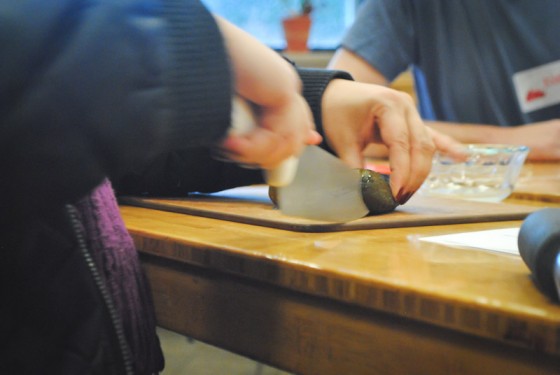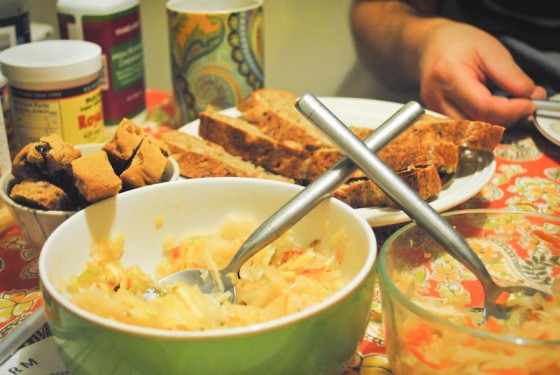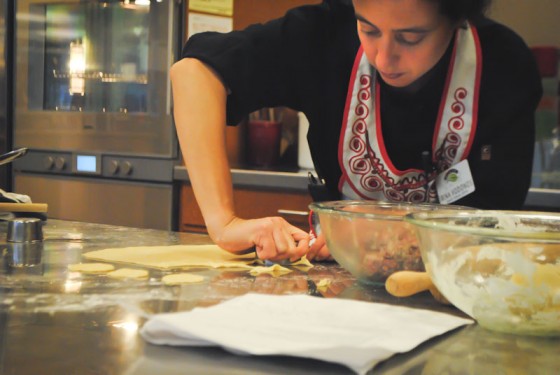If you want great Russian food in Seattle, you might have to cook it yourself. And Moscow transplant Irina Vodonos wants to teach you.
Unless you had a Russian grandmother or identify as one of those rare breeds of Dostoyevsky-obsessed Russophiles, Eastern European food doesn’t typically make it onto the list of flashy global cuisines. There is a dearth of Russian influence in major cooking schools, or in the top restaurants around town.
The truth is, the mastery of Russian food belongs in the hands of the unassuming home cook.
Irina Vodonos is one of the best. She’s a non-profit worker turned cooking instructor, who will be sharing her secrets in cooking classes at PCC locations around the Northwest over the next two weekends and then at The Pantry in Ballard in March.
Together with her husband she runs an impressive kitchen out of their home in Queen Anne. It is there that Vodonos tests out recipes from borscht to pelmeni to a variety of preserves sold on her website, while her husband works on his sauerkraut.
Vodonos, who grew up in Moscow, draws on her family’s Russian-Jewish influence, using many of her family and friend’s recipes passed down through word of mouth.
“Many dishes that Americans think of as Jewish food are actually commonly eaten throughout Eastern Europe,” Vodonos says.
Indeed, some of her recipes used in classes would be all-to familiar to Ashkenazi Jews like my Brooklyn-bred father, who might go weak in the knees hearing her describe the process of making schmaltz, rendered chicken fat and it’s counterpart, gribenes, the leftover skin cracklings, cooked down with onion.
Who said these recipes have to die with our great-grandmothers?
This March, recipes from Vodonos’ kitchen like schmaltz and shchi (cabbage soup), will make their debut at The Pantry at Delancey, a shiny community kitchen started by local chef and DIY enthusiast Brandi Henderson. The school, an extension of the hip Ballard pizzeria, Delancey, has classes — which often sell out in minutes — that feature underrepresented cuisines and different cooking techniques.
“She mentioned that she could cook a soup that involved a flaming piece of wood — who can say no to that?” mused Henderson, who has featured professionally-trained chefs, food writers and photographers, and informally-trained instructors like Vodonos.
Though Russian and Eastern European style cooking classes are harder to find, Vodonos’ classes are well suited to a national trend that favors do-it-yourself cooking, canning, and preserving, fostered by both the environmental movement and a lackluster economy.
 Participants in PCC Cooks class, ‘Winter Nights in Siberia,’ chop pickles for rassolnick. (Photo by Anna Goren)
Participants in PCC Cooks class, ‘Winter Nights in Siberia,’ chop pickles for rassolnick. (Photo by Anna Goren)
Back in Moscow, however, the food trends seem to be moving in the opposite direction.
“It is definitely not hip to be making everything from scratch,” remarks Vodonos, who notes that as the economy returns and Russians are drawn to urban life, people choose to cook prepared foods, much in the same way that Americans did in the 1950s and ’60s, or to eat out.
Like many other Russian Jews, Vodonos came to the United States with her family in the mid 1990’s as refugees. She landed in Los Angeles and later, New York, where she earned her undergraduate degree, before settling in Seattle with her husband. She recently graduated from the University of Washington, where she earned her MPA and MA at the Jackson School of International Studies.
Always an avid cook, friends urged her to pursue private catering and classes as a way to continue working part-time throughout graduate school. Once she started, she couldn’t get herself to stop.
As a child Vodonos spent summers in Lithuania, a lush region then part of the Soviet Union that’s known for forests full of berries and mushrooms — not unlike the Pacific Northwest. It was there where she learned the process of making jams, preserves, and kompot, a drink of stewed fruit. Unlike the British tea traditions of jam and crumpets, Vodonos recalls bringing home batches of Lithuanian preserves to Moscow, where for the duration of winter, the family sat around the table eating jam by the spoonful, washing it down with sips of tea.
The Russian food that is Vodonos’s expertise is not haute cuisine, per se. Instructions are loose and up for interpretation, ingredients are simple and cheap, and the secret to its distinct earthy and comforting flavor is mostly time.
Even kitchen utensils are not stringent — Vodonos talked of improvising while making pelmeni, (a smaller, meat-filled cousin of the better-known piroshky), by using a shot glass to measure the dough in the absence of cookie-cutters. She calls it “the Russian way,” coming from a culture where people facing long, harsh winters with few resources were able to adapt to their environment with ingenuity.
Even today, people in Moscow living in apartment buildings might use their decks to refrigerate or freeze large batches of food, according to Vodonos.
 From left; sukhariki — a hazelnut tea cookie, sauerkraut with cabbage and carrot, and a version with olive oil and cranberries. (Photo by Anna Goren)
From left; sukhariki — a hazelnut tea cookie, sauerkraut with cabbage and carrot, and a version with olive oil and cranberries. (Photo by Anna Goren)
For a sulking Seattle foodie longing for the produce of summertime, Russian cuisine is a dark horse during these months: it centers on hardy ingredients that thrive in the cold, and create a product that is comfort food at its best.
Vodonos’s husband hails from a city in Siberia that was closed off to most foreign visitors until the 1990’s, and is known for its especially long and bitter winters. He still uses the sauerkraut recipe he grew up making in large batches, which stored outside for most of the year.
Russian sauerkraut uses carrots and cabbage, both widely available during the winter months, and relies on nothing but salt and patience to create a complex, healthy-bacteria filled condiment that is an elevated version of the vinegar-y versions we see in stores.
As a cook with a penchant for leftovers, I was especially drawn to Vodonos’ care to use and re-use ingredients, the secret weapon of any home cook. One such recipe is rassolnik, a barley and beef soup flavored with pickle brine. For those of us who have found nothing better to do with the precious salty liquid at the end of the pickle jar than toss it back after a shot of whisky, the recipe is something special.
Perhaps aside from the famous Piroshky, Piroshky in Pike Place Market, Russian restaurants in Seattle still come second to a home-cooked meal with Irina Vodonos. If you’re lucky enough to take one of her classes this winter, it might be the next best thing to a seat at her kitchen table.



Thank you for such a wonderful and well-written article, Anna, and for helping draw broader attention to Russian and Eastern European cuisine! The link provided in the article to the Winter Nights in Siberia class schedule and registration web page does not seem to work, so I am including it here for those who may want to attend the two remaining classes: http://www.pccnaturalmarkets.com/pcccooks/classes/detail.php?id=1352.
link fixed! Thanks Irina